Get weekly
HubSpot updates
SaaS pricing can be a bit of a grey area. The value your product gives to a customer is often unrelated to the cost of developing and continuously updating the software.
Your SaaS pricing strategy should be centred around your customers and your growth goals, which means that the packages and plans you formulate will evolve as time goes by. The very nature of the SaaS industry requires careful and continuous attention to pricing in order to keep your business competitive and your churn rate down.
If you're currently reviewing your own pricing strategy or wondering where to start, this blog will give you some inspiration and a few ideas about what other SaaS businesses are currently doing right when it comes to pricing.
Remember, your market is the determining factor when it comes to establishing whether you're pricing appropriately. So before you jump into applying any strategy, ensure that you have a thorough understanding of what's going to work in your particular environment and industry.
What affects your pricing strategy?
- Competitors and the current market.
- Customer's perceived value of your product.
- The level of after-sales support you will have to factor into your budget.
- Your cost of acquiring a customer.
With that in mind, let's take a look at some ingenious pricing plans.
1.HubSpot
Go big or go home, right? Let's start with what is perhaps one of the most carefully formulated SaaS pricing pages out there. HubSpot sells a multilayered product that offers a range of benefits and features. It must have been a mammoth challenge to figure out how to present each facet of their product in a palatable way that gives the client a clear understanding of what it is they're looking for and how it addresses their needs. HubSpot has undoubtedly done a great job here.
To begin with, they've created this interactive page, which allows you to switch between tabs as you check out the features of each product/hub: Sales, Marketing, and Service.
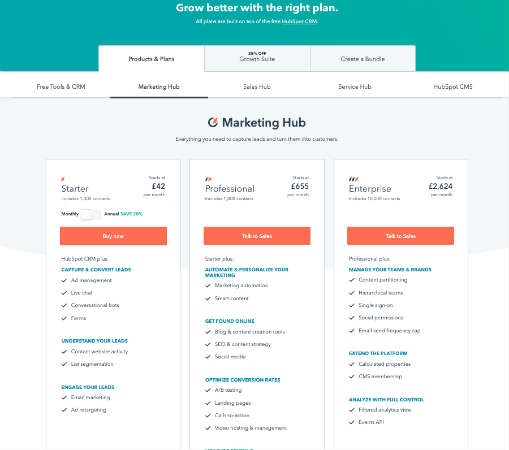
Each hub presents a tiered system of pricing according to your status as a business: Starter, Professional, or Enterprise.
This pricing strategy gets even better. HubSpot clearly understands what may be driving clients to this page. They know that their product appeals to businesses that are looking to push past the glass ceiling and grow, and these customers know that they need the tools to help them do this. To target this audience, and simplify the decision-making process for them, HubSpot features another tab titled "Growth Suite." Here, customers can quickly ascertain which bundle meets their needs and select the one that applies to them. This is also clearly a promotional effort as the customer gets a 25% discount by choosing a pricing package in this category — another fantastic way to boost conversion.

Lastly, and perhaps the tab that needs the most applause, is the "Custom Bundle" option. Here, customers can self-select the hubs, ad-ons, and services they require. This is a particularly unique feature because although HubSpot isn't the first company to offer custom pricing, there aren't many around that give you the full buffet menu. Usually, bespoke pricing requires the customer to call up the business and speak to an advisor. This method is far more transparent and in line with inbound marketing practices. It gives the customer all the information he or she may need without trying to push them into any add-on features that they may not want, which is often the concern customers have when they have to call up a company – Will I have to listen to the whole sales spiel before I can get down to purchasing what I want?
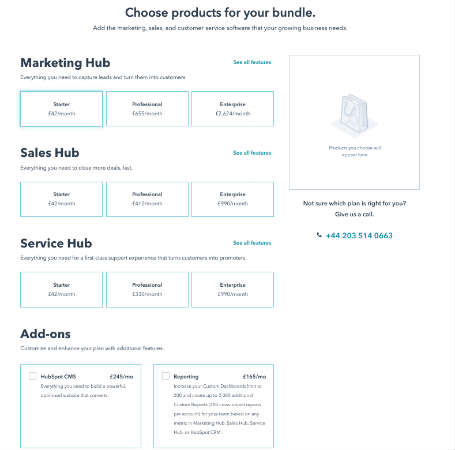
HubSpot's strategy:
- Provide the customer with as much information as they need to understand the value of your software's features.
- Guide the customer towards a price plan that meets the level of service requirements they have.
- Simplify the decision-making process by allowing the customer to stay in control of what they are purchasing.
2. Freshservice
Freshservice is a cloud-based IT service desk that helps users to access knowledge and self-manage the IT services they require.
Each package is available for a full access free trial, so there are no restrictions when it comes to giving each targeted persona a taste of the software's benefits. There are four available price plans, each enabled for monthly or annual billing – except the Enterprise option.
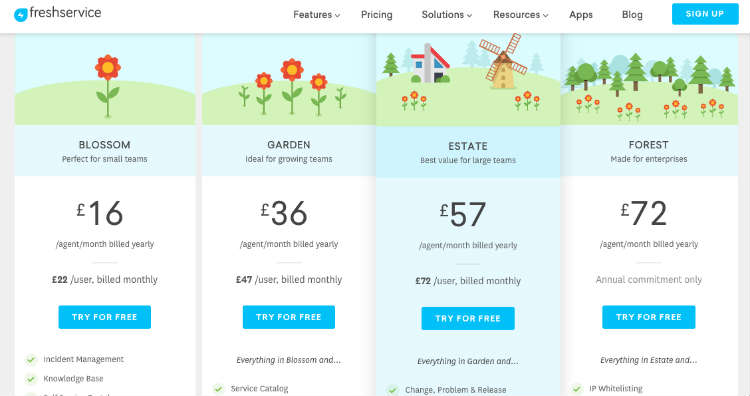
Freshservice's prices seem reasonably accessible, regardless of the user level, and they've done a great job of conveying the value offered by each package. HubSpot has listed Freshservice as one of the Top 30 SaaS companies to watch in 2019, and with good reason.
We can see that Freshservice is all about trust-building by assuring customers that no credit card details will be required for their free trial.

Freshservice's strategy:
- Offer clear value to the user with comprehensive feature descriptions.
- Encourage user commitment by offering better prices on annual subscriptions when compared with monthly rates. This is bolstered by the price comparison feature also offered on the landing page. =
- They understand that deciding to sign up for their service may require a higher level of management approval, so they've created content assets that can be shared throughout the business with decision-makers. It also acts as a clever CTA to get the lead’s email.
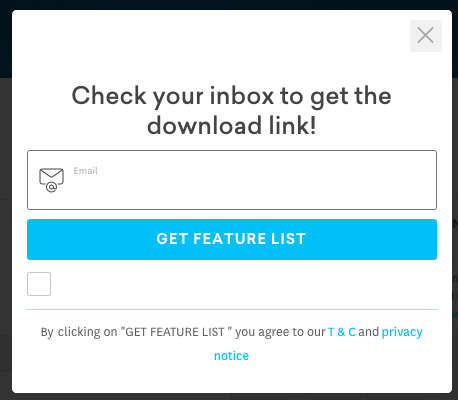
- Their pricing is based on the size of the team their client is likely to have, as illustrated in the copy.
3. Proofpoint
Like all the other big players in online security, Proofpoint doesn't have a pricing page.
Nope. No pricing on display. Have a look at McAfee for business or Sophos – nothing to see there either.
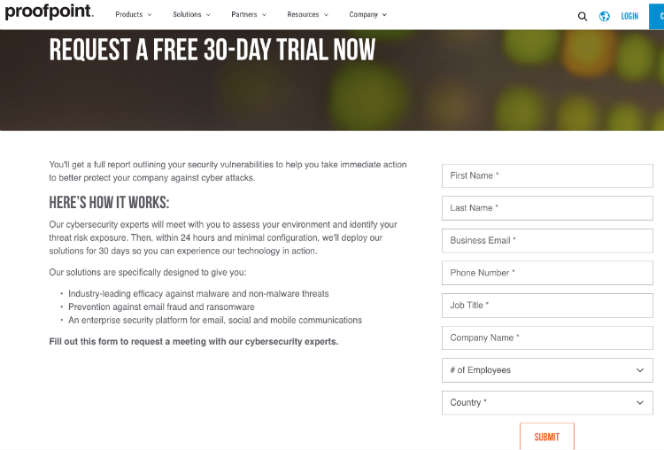
Proofpoint does offer a 30-day free trial, during which they create a full report of all the vulnerabilities the user's company is exposed to. In a B2B scenario, this price plan can make a lot of sense when it comes to cybersecurity. Each organisation will have a unique set of requirements depending on the kind of data they handle and the industry they operate in. It's not going to be an out-of-the-box installation process, and there are going to be a whole host of devices that need to be evaluated and protected.
Proofpoint's strategy:
- By asking users to fill out a form before they can access the free trial, Proofpoint is able to qualify leads effectively and deploy their experts with the right information at hand.
- The free trial comes with a high level of personalisation, where the solution is evidently tailored to the client's security needs. This certainly gives an air of exclusivity to the service.
- Proofpoint doesn't supply any prices, but their website is filled with content to educate visitors on all aspects of their products and why their features are essential for businesses looking to guard their digital assets against threats. Because cybersecurity is a complex and technical topic, Proofpoint knows that decision-makers need first to understand the necessity of their product so that the price they pitch is directly tied to the value the customer is getting. It's kind of like selling insurance, you're paying for something you hope never to have to use, but if you don't understand the implications of not having insurance, you're going to be a little resistant about paying a hefty premium. It's a similar sentiment when it comes to cybersecurity software, which is why educational content is a must for this kind of product, something Proofpoint does very well.
We've explored three somewhat different SaaS pricing strategies. There are certainly many more unique and successful alternatives out there. But the critical takeaway for your business should be that SaaS pricing is something you're not likely to get right on the first go; or, if you do, you're probably selling a very basic product that doesn't require a multilayered pricing model. Still, you've probably done some A/B testing at different price points and optimised your pricing page for conversion, right? If you haven't, take a look at this blog we created to help you generate more leads from your SaaS pricing pages.
Remember, your pricing strategy should always focus on your buyer persona – that's number one. If you're shooting too high or using language and tactics that don't translate the value of your product to the person you expect to pay for it, expect to see a lot of churn from your free trials and plenty of bouncing from your pricing pages.
To speak to us about your current SaaS pricing strategy or find out more about optimising your website and content for conversion, give us a call.

